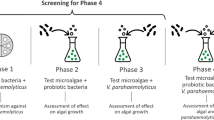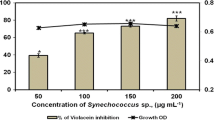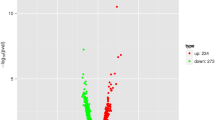Abstract
The results of our previous study demonstrated that the total Vibrio count in a fish aquarium could be limited to a low level through the introduction of Picochlorum sp. S1b. In subsequent trials, we discovered that Picochlorum sp. S1b demonstrated a strong inhibitory effect on Vibrio only when cultivated in a nonsterile environment. This is a clear indication that the inhibitory effects cannot be attributed to Picochlorum sp. S1b directly, but rather to bacteria associated with it. In the current study, we isolated bacterial strains with a strong inhibitory effect on Vibrio spp. These strains were obtained from nonsterile cultures of Picochlorum sp. S1b. To evaluate the anti-Vibrio activity, we co-cultured these bacterial strains with S1b and later with pathogenic Vibrio harveyi and Vibrio campbellii. Our results indicate that among the 80 strains, only six strains belonging to either the Rhodobacteraceae or Flavobacteriaceae were linked to a significant decrease in total Vibrio count under co-culture conditions. Further study will be required to elucidate the interactions among these six bacterial strains and the Picochlorum sp. S1b with regard to anti-Vibrio activity.




Similar content being viewed by others
References
Alabi AO, Jones DA, Latchford JW (1999) The efficacy of immersion as opposed to oral vaccination of Penaeus indicus larvae against Vibrio harveyi. Aquaculture 178:1–11
Amaro HM, Guedes AC, Malcata FX (2011) Antimicrobial activities of microalgae: an invited review. In: Mendez-Vilas A (ed) Science against Microbial pathogens: communicating current research and technological advances. Formatex, Badajoz
Austin B, Pride AC, Rhodie GA (2003) Association of a bacteriophage with virulence in Vibrio harveyi. J Fish Dis 26:55–58
Bab-Dinitz E, Shmuely H, Maupin-Furlow J, Eichler J, Shaanan B (2006) Haloferax volcanii PitA: an example of functional interaction between the Pfam chlorite dismutase and antibiotic biosynthesis monooxygenase families? Bioinformatics 22:671–675
Bell WH, Lang JM, Mitchell R (1974) Selective stimulation of marine bacteria by algal extracellular products. Limnol Oceanogr 19:833–839
Bruhn JB, Nielsen KF, Hjelm M, Hansen M, Bresciani J, Schulz S, Gram L (2005) Ecology, inhibitory activity, and morphogenesis of a marine antagonistic bacterium belonging to the Roseobacter clade. Appl Environ Microbiol 71:7263–7270
Chen T-Y, Lin H-Y, Lin C-C, Lu C-K, Chen Y-M (2012) Picochlorum as an alternative to Nannochloropsis for grouper larval rearing. Aquaculture 338–341:82–88
Chen Y, Tang J, Tang X, Wang C, Lian Y, Shao Z, Yao X, Gao H (2013) New phenethylamine derivatives from Arenibacter nanhaiticus sp. nov. NH36AT and their antimicrobial activity. J Antibiot 66:655–661
Crosbie PBB, Nowak BF (2004) Immune responses of barramundi, Lates calcarifer (Bloch), after administration of an experimental Vibrio harveyi bacterin by intraperitoneal injection, anal intubation and immersion. J Fish Dis 27:623–632
Defoirdt T, Boon N, Bossier P, Verstraete W (2004) Disruption of bacterial quorum sensing: an unexplored strategy to fight infections in aquaculture. Aquaculture 240:69–88
Defoirdt T, Boon N, Sorgeloos P, Verstraete W, Bossier P (2007) Alternatives to antibiotics to control bacterial infections: luminescent vibriosis in aquaculture as an example. Trends Biotechnol 25:472–479
Defoirdt T, Sorgeloos P, Bossier P (2011) Alternatives to antibiotics for the control of bacterial disease in aquaculture. Curr Opin Microbiol 14:251–258
Egidius E (1987) Vibriosis: pathogenicity and pathology. A review. Aquaculture 67:15–28
González JM, Simó R, Massana R, Covert JS, Casamayor EO, Pedrós-Alió C, Moran MA (2000) Bacterial community structure associated with a dimethylsulfoniopropionate-producing North Atlantic algal bloom. Appl Environ Microbiol 66:4237–4246
Huntemann M, Teshima H, Lapidus A, Nolan M, Lucas S, Hammon N, Deshpande S, Cheng J-F, Tapia R, Goodwin L, Pitluck S, Liolios K, Pagani I, Ivanova N, Mavromatis K, Mikhailvova N, Pati A, Chen A, Palaniappan K, Land M, Hauser L, Pan C, Brambilla E, Rohde M, Spring S, Göker M, Detter JC, Bristow J, Eisen JA, Markowitz V, Hugenholtz P, Kyrpides NC, Klenk H-P, Woyke T (2012) Complete genome sequence of the facultatively anaerobic, appendaged bacterium Muricauda ruestringensis type strain (B1 T). Stand Genomic Sci 6:185–193
Kokou F, Makridis P, Kentouri M, Divanach P (2012) Antibacterial activity in microalgae cultures. Aquacult Res 43:1520–1527
Lam FW-S, Wu S-Y, Lin S-J, Lin C-C, Chen Y-M, Wang H-C, Chen T-Y, Lin H-T, Lin JH-Y (2011) The expression of two novel orange-spotted grouper (Epinephelus coioides) TNF genes in peripheral blood leukocytes, various organs, and fish larvae. Fish Shellfish Immunol 30:618–629
Lavilla-Pitogo CR, Leaño EM, Paner MG (1998) Mortalities of pond-cultured juvenile shrimp, Penaeus monodon, associated with dominance of luminescent vibrios in the rearing environment. Aquaculture 164:337–349
Lio-Po GD, Leaño EM, Peñaranda MMD, Villa-Franco AU, Sombito CD, Guanzon NG Jr (2005) Anti-luminous Vibrio factors associated with the ‘green water’ grow-out culture of the tiger shrimp Penaeus monodon. Aquaculture 250:1–7
Liu PC, Chen YC, Huang CY, Lee KK (2000) Virulence of Vibrio parahaemolyticus isolated from cultured small abalone, Haliotis diversicolor supertexta, with withering syndrome. Lett Appl Microbiol 31:433–437
Makridis P, Costa RA, Dinis MT (2006) Microbial conditions and antimicrobial activity in cultures of two microalgae species, Tetraselmis chuii and Chlorella minutissima, and effect on bacterial load of enriched Artemia metanauplii. Aquaculture 255:76–81
Míguez B, Combarro MP (2003) Bacteria associated with sardine (Sardina pilchardus) eggs in a natural environment (Ría de Vigo, Galicia, northwestern Spain). FEMS Microbiol Ecol 44:329–334
Natrah FMI, Kenmegne MM, Wiyoto W, Sorgeloos P, Bossier P, Defoirdt T (2011) Effects of micro-algae commonly used in aquaculture on acyl-homoserine lactone quorum sensing. Aquaculture 317:53–57
Naviner M, Bergé JP, Durand P, Le Bris H (1999) Antibacterial activity of the marine diatom Skeletonema costatum against aquacultural pathogens. Aquaculture 174:15–24
Nicolas JL, Corre S, Gauthier G, Robert R, Ansquer D (1996) Bacterial problems associated with scallop Pecten maximus larval culture. Dis Aquat Org 27:67–76
Ningqiu L, Junjie B, Shuqin W, Xiaozhe F, Haihua L, Xing Y, Cunbin S (2008) An outer membrane protein, OmpK, is an effective vaccine candidate for Vibrio harveyi in orange-spotted grouper (Epinephelus coioides). Fish Shellfish Immunol 25:829–833
Pereira C, Silva YJ, Santos AL, Cunha GNCM, Almeida A (2011) Bacteriophages with potential for inactivation of fish pathogenic bacteria: survival, host specificity and effect on bacterial community structure. Mar Drugs 9:2236–2255
Rattanachuay P, Kantachote D (2007) Selection of proteolytic bacteria with ability to inhibit Vibrio harveyi during white shrimp (Litopenaeus vannamei) cultivation. Songklanakarin J Sci Technol 29:235–243
Sakai M (1999) Current research status of fish immunostimulants. Aquaculture 172:63–92
Salvesen I, Reitan K, Skjermo J, Oie G (2000) Microbial environments in marine larviculture: impacts of algal growth rates on the bacterial load in six microalgae. Aquacult Int 8:275–287
Sharifah EN, Eguchi M (2011) The phytoplankton Nannochloropsis oculata enhances the ability of Roseobacter clade bacteria to inhibit the growth of fish pathogen Vibrio anguillarum. PLoS ONE 6:e26756
Sommerset I, Krossøy B, Biering E, Frost P (2005) Vaccines for fish in aquaculture. Expert Rev Vaccines 4:89–101
Tamura K, Peterson D, Peterson N, Stecher G, Nei M, Kumar S (2011) MEGA5: molecular evolutionary genetics analysis using maximum likelihood, evolutionary distance, and maximum parsimony methods. Mol Biol Evol 28:2731–2739
Tendencia EA, Dela Peña M (2003) Investigation of some components of the greenwater system which makes it effective in the initial control of luminous bacteria. Aquaculture 218:115–119
Teplitski M, Chen H, Rajamani S, Gao M, Merighi M, Sayre RT, Robinson JB, Rolfe BG, Bauer WD (2004) Chlamydomonas reinhardtii secretes compounds that mimic bacterial signals and interfere with quorum sensing regulation in bacteria. Plant Physiol 134:137–146
Thanardkit P, Khunrae P, Suphantharika M, Verduyn C (2002) Glucan from spent brewer’s yeast: preparation, analysis and use as a potential immunostimulant in shrimp feed. World J Microbiol Biotechnol 18:527–539
Thompson FL, Iida T, Swings J (2004) Biodiversity of vibrios. Microbiol Mol Biol Rev 68:403–431
Thuy NTT, Nguyen DH, Wergeland HI (2013) Specific humoral immune response and protection against Vibrio parahaemolyticus in orange-spotted grouper Epinehelus coioides. Int J Aquat Sci 4:24–35
Toranzo AE, Magariños B, Romalde JL (2005) A review of the main bacterial fish diseases in mariculture systems. Aquaculture 246:37–61
Turner S, Pryer KM, Miao VPW, Palmer JD (1999) Investigating deep phylogenetic relationships among cyanobacteria and plastids by small subunit rRNA sequence analysis. J Eukaryot Microbiol 46:327–338
Vinod MG, Shivu MM, Umesha KR, Rajeeva BC, Krohne G, Karunasagar I, Karunasagar I (2006) Isolation of Vibrio harveyi bacteriophage with a potential for biocontrol of luminous vibriosis in hatchery environments. Aquaculture 255:117–124
Acknowledgments
We would like to thank M. Ash for editing of this manuscript. This work was supported by grants (NSC 100-2621-B-006-002-MY3 and NSC 101-2324-B-006-004).
Author information
Authors and Affiliations
Corresponding author
Additional information
Jung-Che Kuo and Yu-Han Chang contributed equally to this paper.
Rights and permissions
About this article
Cite this article
Kuo, JC., Chang, YH., Chen, TY. et al. Elucidation of anti-Vibrio factors associated with green alga Picochlorum sp. strain S1b. J Appl Phycol 27, 257–265 (2015). https://doi.org/10.1007/s10811-014-0288-4
Received:
Revised:
Accepted:
Published:
Issue Date:
DOI: https://doi.org/10.1007/s10811-014-0288-4




